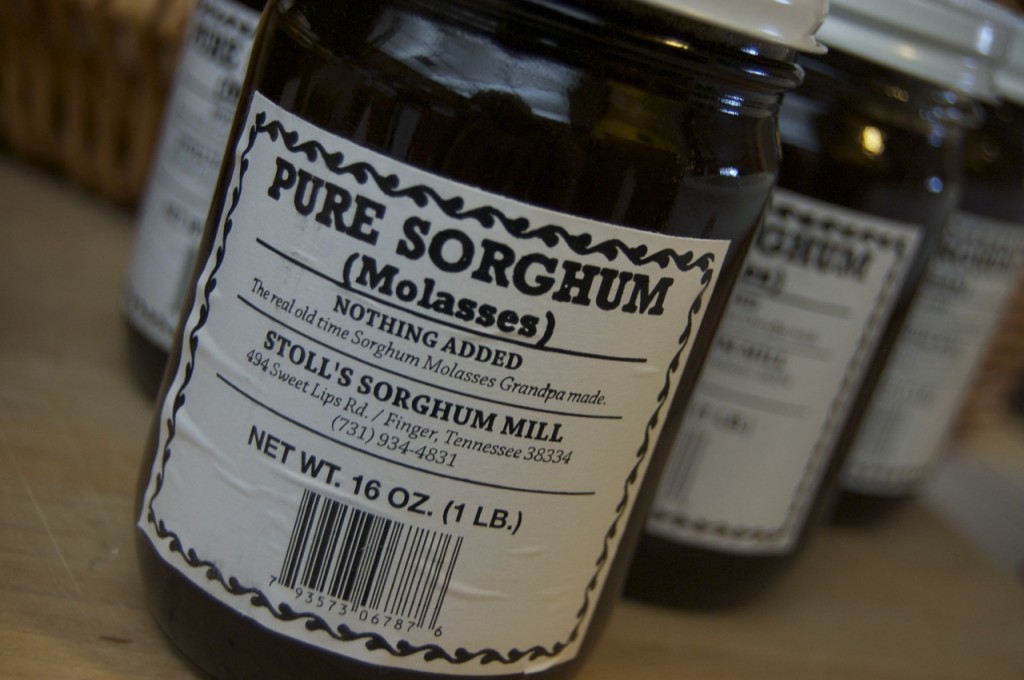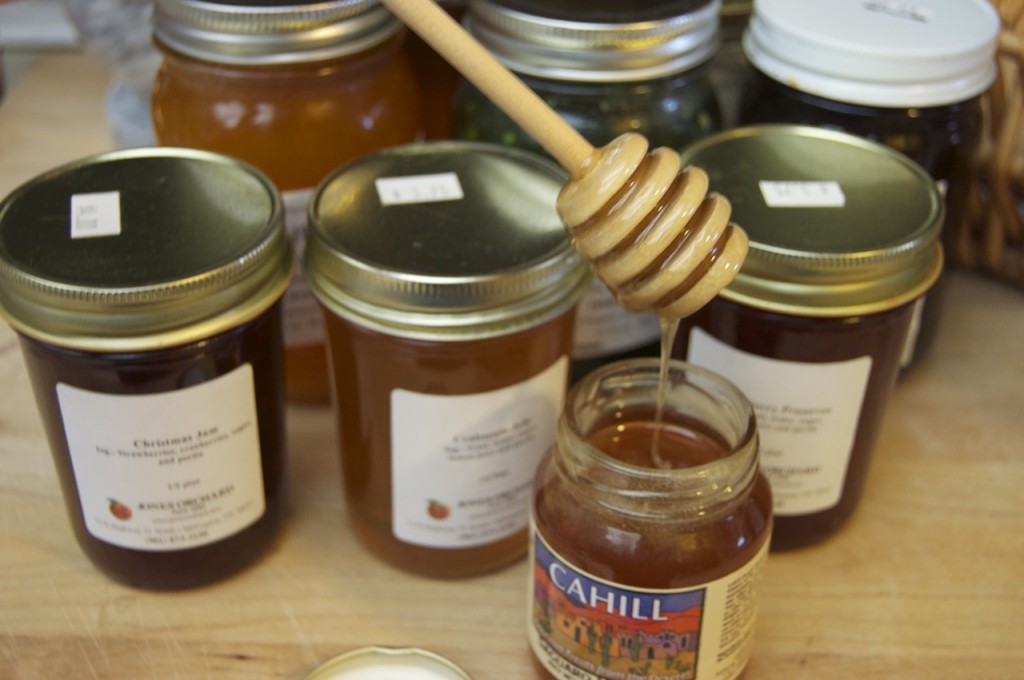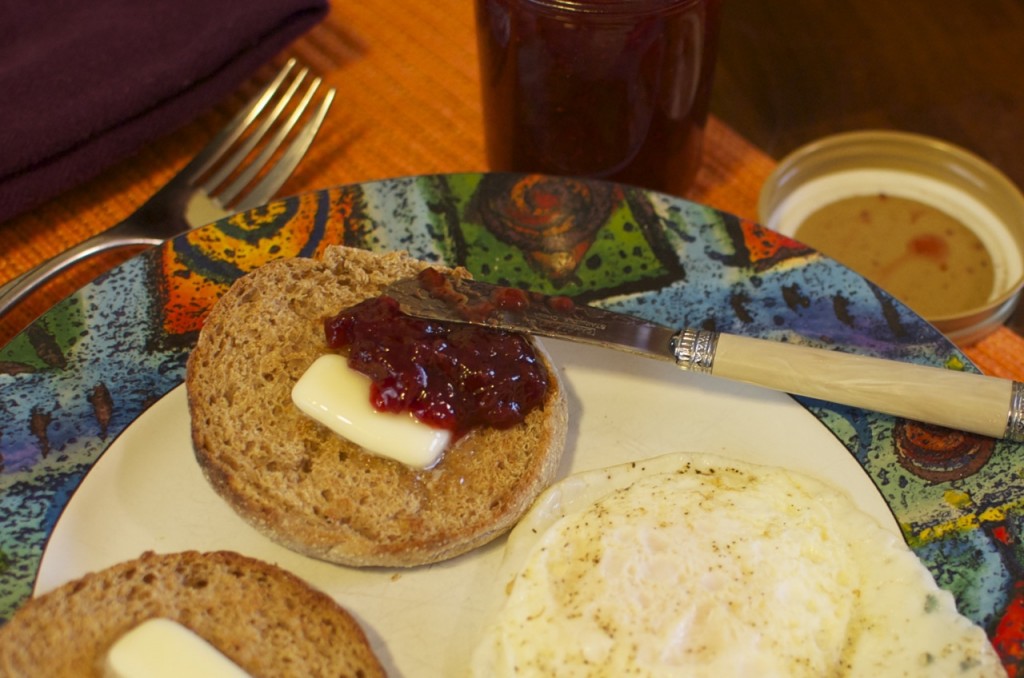I’ve just returned from a visit back home in Memphis. This time I had the luxury of being able to carry more or less what I wanted when I returned to California because we drove back. The trade-off was not being able to keep good pork products frozen for the several days we spent making our way across the country. That works best with air travel.
But this is about what I DID bring back. For some time now I’ve been eager to stock up on sorghum molasses. I can find molasses in California, but honestly, I wonder where that harsh-tasting stuff comes from (I suspect it’s from a motor oil reclamation facility somewhere on the fringes of the high desert). So I hit Easy Way in Memphis and bought four jars of locally produced sorghum molasses to carry back.
Note the address. This sorghum comes from Sweet Lips Road in Finger, Tennessee. And that’s pronounced “Fanger,” in case you didn’t know. For me it just doesn’t get any more down home than this. Sorghum molasses is golden and sweet and rich but not overpowering. It tastes like West Tennessee in a jar and provides me with my very own Proustian experience. It’s divine on hot biscuits, but just between you and me, sometimes I open the jar when nobody’s looking and stick my fingers in and lick them off. Sweet lips AND sweet fangers!
This gave me the idea to collect canned, locally produced sweets along the way as we drove back. Before leaving Memphis I stopped off at the farmers’ market and picked up crabapple jelly, strawberry preserves (having just missed strawberry season) and “Christmas jam,” a combo of strawberries and cranberries (of course I’m assuming the producers have a good deal of their freezer space devoted to those non-local cranberries they’d have to stock up on during the holidays to be making Christmas jam come summertime).
In the Texas Panhandle I bought a couple of jams, apricot and jalapeño. I don’t expect the jalapeño jam will want to be on my toast, but I have plans to experiment with it and discover all the ways it can best showcase what it has to offer. Stirring a spoonful of apricot jam into a bowl of oatmeal and topping it with a handful of toasted walnuts is what I call five-second-gourmet-breakfast.
In New Mexico I picked up a tiny jar of saguaro honey, which comes from the blossoms of the saguaro cactus, the iconic cactus you see in the Roadrunner cartoons. Maybe it’s just my imagination, but I swear I can taste the desert in it.
What’s so special about all this stuff?
It gives you a much better taste of a place than its equivalent from your local gigantomart. And really, that’s no equivalent. Most commercially produced honey is iffy stuff. Having been microfiltered to remove the pollen, it’s impossible to identify the honey’s origin, resulting in a product that could be from anywhere and that could have anything in it, including high fructose corn syrup and antibiotics. Sample a locally-produced honey and, as with wines and other locally produced edibles and drinkables, you’ll taste the place of origin.
As for jams, jellies and preserves, chances are that when you buy these lovely sweets produced in small batches by individuals rather than huge companies, you’ll no doubt taste more fruit than sugar. Perhaps they’ll be made with natural pectin rather than the store-bought stuff that makes the product stiff enough to hold up a spoon. They’ll probably be fresher, too, made recently and not stashed in a warehouse for distribution in the next decade.
Buying locally made preserves and honey means you’ll be able to find things produced only in that area. Where else but the American Southwest are you likely to find saguaro honey? Someone in Memphis might make preserves from kiwi fruit and meyer lemons bought at the grocery, but it’s just not going to be as good as the jar of kiwi-meyer lemon preserves I recently bought at the North Hollywood Farmers’ Market in LA, made from locally grown fruit picked ripe and used right away (not picked green and shipped across the country).
While I don’t have the palate to distinguish between all the different honeys I’ve tried, my tongue absolutely can tell me when I’m tasting a honey that’s just that–pure honey with no corn syrup added. Sad thing is, so much of the fake stuff is sold these days that a lot of people can’t tell when they’re tasting the real thing. They might actually prefer the fake stuff because it’s all they recognize. Sadder still, such is the case with maple syrup.
While we didn’t have unlimited time and money for scouring the countryside between Memphis and Los Angeles for every homemade preserve and honey out there, it was fun to see what was available at each place we stopped for go-juice, eats and snooze. Rather than the usual t-shirts and assorted flotsam available at every souvenir stand (local themed but mostly made in China), I opted for a taste of the territory. I’ll enjoy my sweet stash, and when it’s all gone, I can either fill the empties with stuff I’ve made or recycle them. No buyer’s remorse over spending $17.95 on a faux stuffed armadillo wearing a tiny t-shirt that says “I ♥ Texas.”
As for me, I ♥ the preserves I got in Texas.



















Most folks don’t know that sorghum is a plant from which the molasses are made. For the non- Southerners, sorghum is pronounced, SOR – gum, (at least in middle Tennessee).
Molasses can also be made from sugar cane. I have been led to believe that the black strap variety is more filtered than the other types.
Blackstrap is a byproduct of the sugar refining process. It’s what’s made from sugar cane when the refined sugar has all been cooked out of it. That last boiling yields blackstrap, which is a lot healthier than refined sugar.
Regular ol’ sorghum molasses seems so, well, refined, by comparison…
Suzanne, you mentioned in a Facebook comment that you like to add sorghum when you’re making chili, to help tame the heat. That’s a great idea!
Thanks!
Carol
what a great post! how fun to collect local canned goodies!
Yeah, these are my favorite souvenirs. I enjoy them and then when they’re gone, they’re pleasant memories–and I don’t have to dust them!
Cheers!
Carol
I would like to live on a road called Sweet Lips. And in Finger (“Fanger”), no less! I’m so curious to taste a molasses like the one you describe. I know just what you mean about store bought molasses tasting somehow off. But since I have nothing to compare it to, I always thought that, no, this must be how it’s supposed to taste. Maybe not?
Hi Jess,
I don’t know if it’s a function of mass production or what that gives some sorghum a harsh edge. Of course, some people LIKE a harsh edge. I personally prefer a good smoky, peaty scotch, and my brew of choice is Guinness. But I love for my sorghum to be gentler, sort of like honey that’s been around the block a time or two. I know that’s not a very precise way of describing something, but sorghum tastes as earthbound as the plant from which it comes, while honey can taste as light and ethereal as a bee’s wings or as pollen on the breeze. Okay, now I have to go get a spoonful of sorghum…purely for professional purposes…heh heh!
Thanks for stopping in. You’ll have to check online and see if any real estate opens up on Sweet Lips Road!
Carol